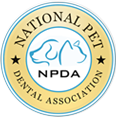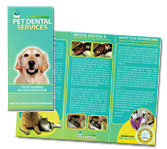“The services provided by Pet Dental Services have proven to be invaluable to our practice. Our clients appreciate the safety and convenience that non-anesthetic dentistry provides to their pets. Pet Dental Service’s staff is incredibly kind and patient with the pets in their care. Even some of our fearful patients are able to benefit from a full dental cleaning due to the gentle care provided by the PDS staff.”
What Are the Signs of Dog Dental Disease?
Dental disease in dogs is a common ailment that affects canines. It is a health condition that is often overlooked by pet owners. It is important for pet owners to pay extra attention to the condition of their pet’s teeth and gums in order to prevent serious dental disease. Some signs of bad oral health in dogs are clear, but there are more subtle symptoms that require pet owners to pay more attention to the behavior of their dogs.
What Are the Signs of Oral Disease in Dogs?
The most common sign of dog dental disease is halitosis, otherwise known as bad breath. Many dog owners may believe it is normal when their pet has unusually bad breath, thus ignoring the signs of periodontal disease. Periodontal disease is an infection of the gums caused by the build-up of plaque on the tooth surface and under the gum line. Within a few days plaque hardens or mineralizes to produce tartar or calculus, which is comprised of dangerous bacteria that can seriously damage the dog’s teeth and gums. Tartar is easy to spot, making it fairly simple for dog owners to take care of the problem before it gets too serious.
Dog dental disease can also be spotted by changes in the gums. Redness, bleeding or inflammation can be signs of gingivitis or stomatitis (serious gum infection). Pet owners should look for these signs as they are indications of periodontal disease. Gingival recession can also be very detrimental to a dog’s dental health because it can lead to root exposure and mobility of the teeth, among other things. Advanced gingival recession can also be an indicator that bone loss is present. Pet owners should become comfortable looking in their dog’s mouth to make sure their gums look healthy.
There are other signs of dog dental disease that are not as noticeable as tartar or gum inflammation around the dog’s teeth. Pets who decline hard crunchy treats may be giving off warning signs of painful dental disease or poor oral health. Dogs may also chew less when eating, causing them to vomit undigested food. Dogs that salivate excessively or paw at their mouth may also be showing symptoms of painful dog dental disease. Even the most experienced observers can miss the signs of poor oral health. It is important dogs have a complete periodontal examination by your veterinarian if dental disease is suspected.
Why Is Dog Dental Disease Important to Spot?
Dental disease in dogs can have serious health repercussions. Dental disease can affect the heart, liver, kidneys, lungs and even the brain. Pets without dental disease often live longer happier lives. A dog’s teeth can suffer from many of the same periodontal issues as humans such as caries (cavities), gingivitis, mobile teeth, fractures and even oral abscesses. Dog dental disease can be very painful for your pet. The more often a dog owner examines their pet’s mouth, the better equipped they will be to discern unusual dental problems and halt serious infections before they cause permanent damage. Always ask your veterinarian to perform an oral exam during your pet’s routine checkups!

 Dr. Melissa Byers
Lake Forest Animal Clinic
Lake Forest, CA
Dr. Melissa Byers
Lake Forest Animal Clinic
Lake Forest, CA







